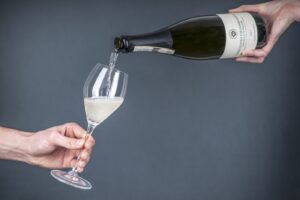Video by winenews.tv:
A molecule that “predicts” the aging ability of red wines: Alexandre Pons, researcher at Isvv in Bordeaux, together with the famous oenologist Denis Dubourdieu explained “3-methyl-2,4-nonadiene” to Wine News
It is a molecule that can quickly "predict" how long it takes a wine to age. The name of this sort of "Sibylline age of Bacchus" is complex, "3-methyl-2, 4 - nonadiene": translated, it is a chemical marker whose lower or higher concentration tells how long a bottle of wine will last. The research group led by Denis Dubourdieu, one of the world's top winemakers, at the Isvv (Institut des Sciences de la Vigne et du Vin de l'Université de Bordeaux), a reference center for applied research in the wine world, made the discovery.
The research began because of the alarm Dubourdieu launched some time before: the great red wines of Bordeaux, which have built much of their fortune and fame on their ability to age well, now risk losing this ability for many reasons, from the climate to vineyard and winery procedures, and so on.
“We continued the research already carried out in the past on premature ageing of white wines,” explained Alexandre Pons, researcher at ISVV in Bordeaux to www.winenews.tv, “in order to identify a marker that could give these indications also for red wines. We discovered this molecule, found in the aromas of aged wines such as plums and stewed fruit, and measuring the concentration in an early period in the life of a wine, it could tell us tomorrow how long it will take that wine to age, before it starts to decay”. Therefore, the less this molecule is present, the longer the wine will last.
"This is a major discovery”, commented Professor Attilio Scienza, leading expert in the world of wine making, “not only for the wines of Bordeaux, whose economic value depends on their resilience to time, from auctions to en primeur sales and so on. Monitoring this marker means being able to predict a wine’s lifespan. And so, for example, when I would like to age a wine but I find out that it will not last, I will try to sell it more quickly without investing any more than needed for its preservation. There has been nothing so accurate and fast in determining this capability before this. It is a very useful tool to properly evaluate the ageing capability of a wine, from vintage to vintage and from place to place as well. The researchers in Bordeaux, for example, evaluated the capability of duration of first level and second level wines from the same Chateau, and have seen that if in the first 3-5 years the differences in the content of this marker are very low, from 5-6 years, its presence begins to increase significantly, but only in the second level wines, while in the first level wines it remains low and this means that these wines have greater ability to age”.
Copyright © 2000/2026
Contatti: info@winenews.it
Seguici anche su Twitter: @WineNewsIt
Seguici anche su Facebook: @winenewsit
Questo articolo è tratto dall'archivio di WineNews - Tutti i diritti riservati - Copyright © 2000/2026








































































































































































































